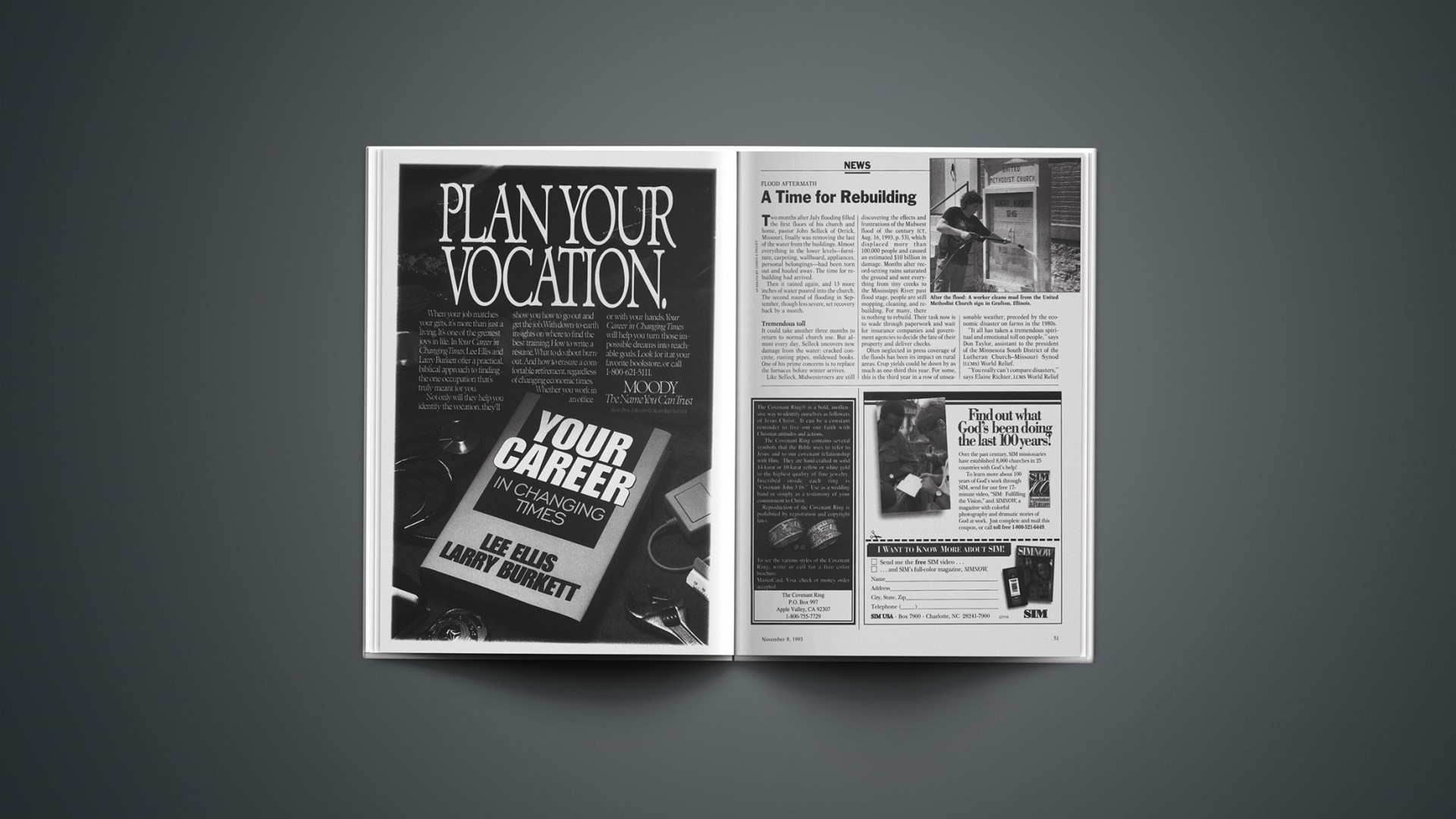Two months after July flooding filled the first floors of his church and home, pastor John Selleck of Orrick, Missouri, finally was removing the last of the water from the buildings. Almost everything in the lower levels—furniture, carpeting, wallboard, appliances, personal belongings—had been torn out and hauled away. The time for rebuilding had arrived.
Then it rained again, and 13 more inches of water poured into the church. The second round of flooding in September, though less severe, set recovery back by a month.
Tremendous toll
It could take another three months to return to normal church use. But almost every day, Selleck uncovers new damage from the water: cracked concrete, rusting pipes, mildewed books. One of his prime concerns is to replace the furnaces before winter arrives.
Like Selleck, Midwesterners are still discovering the effects and frustrations of the Midwest flood of the century (CT, Aug. 16, 1993, p. 53), which displaced more than 100,000 people and caused an estimated $10 billion in damage. Months after record-setting rains saturated the ground and sent everything from tiny creeks to the Mississippi River past flood stage, people are still mopping, cleaning, and rebuilding. For many, there is nothing to rebuild. Their task now is to wade through paperwork and wait for insurance companies and government agencies to decide the fate of their property and deliver checks.
Often neglected in press coverage of the floods has been its impact on rural areas. Crop yields could be down by as much as one-third this year. For some, this is the third year in a row of unseasonable weather, preceded by the economic disaster on farms in the 1980s.
“It all has taken a tremendous spiritual and emotional toll on people,” says Don Taylor, assistant to the president of the Minnesota South District of the Lutheran Church-Missouri Synod (LCMS) World Relief.
“You really can’t compare disasters,” says Elaine Richter, LCMS World Relief associate director. “But this is the largest emergency we have ever been involved in, in terms of the number of miles covered.” In her experience, for every day of a disaster’s impact, ten days of relief are needed, and one hundred days of recovery are necessary.
Christians cooperate
The flood prompted cooperation that crossed many denominational, racial, and social lines. In Des Moines, where flood waters knocked out the water-treatment plant and left the city without running water for more than two weeks, nearly 60 churches formed the Christian Relief Effort. The churches became a channel for housing, fresh water, and disaster assistance. The group collected more than $300,000.
In October, a manufacturer loaned a recreational vehicle to the group to provide on-site counseling to flood victims. “We’ve found people reluctant to leave the areas,” says director Gary Jones. So pastors, counselors, and trained lay volunteers go to them to offer “stress education.”
Past experience played a role in the interchurch relief efforts. Philip Huber, a disaster consultant from Gettysburg, Pennsylvania, who worked in Des Moines, says, “When the Southern Baptists are here, we know they are feeding people. When the Mennonites are here, we know they will be doing building repairs. For Lutherans, it is often primarily pastoral care.”
Aid has poured into the Midwest from large agencies, small churches, and individuals. World Vision distributed nearly $2 million in food and supplies in four states. In the St. Louis area, the Salvation Army took charge of training and dispatching more than 4,000 volunteers.
Many churches have sent offerings and volunteer teams to help in cleanup and recovery. Volunteers arrived in the Midwest from as far away as Washington and Florida, bringing everything from carpenters’ tools to pizza ingredients.
What concerns recovery organizers now is the inevitable “compassion fatigue” that follows major disasters. Media attention has long since turned from the area, yet a tremendous amount of work remains. “It’s one thing to get people to help fill sandbags,” says Jones. “It’s another to get them to help carry them away.”
More troubling still is the meteorological warnings that spring snow melt and rain on the still-saturated soil could bring another round of flooding.
By Ken Sidey in Greenfield, Iowa.










